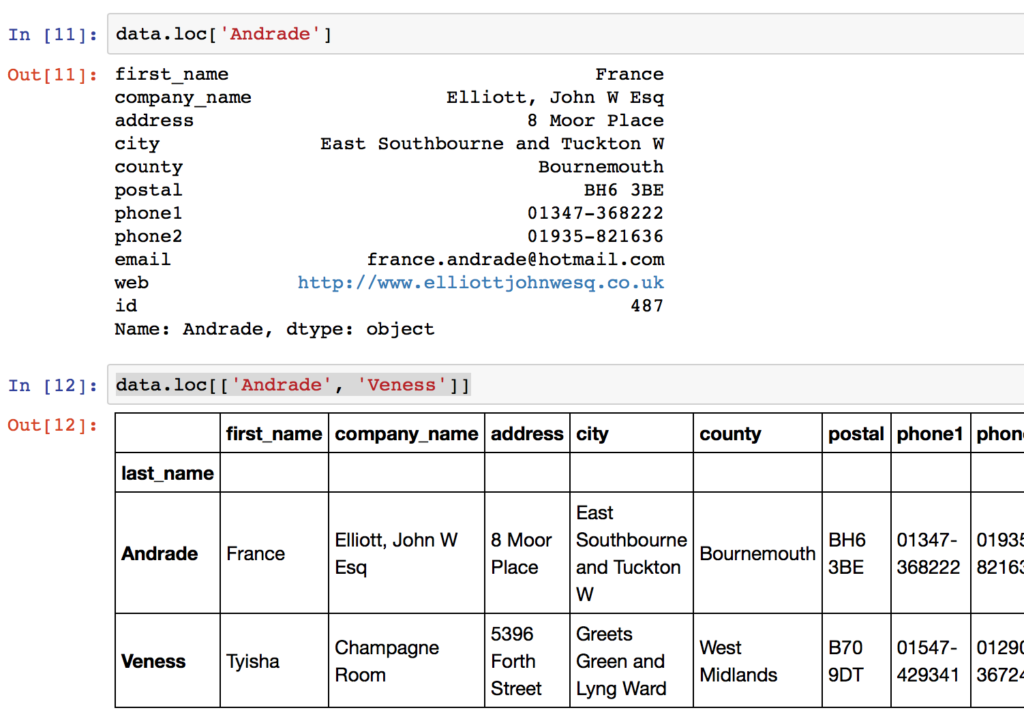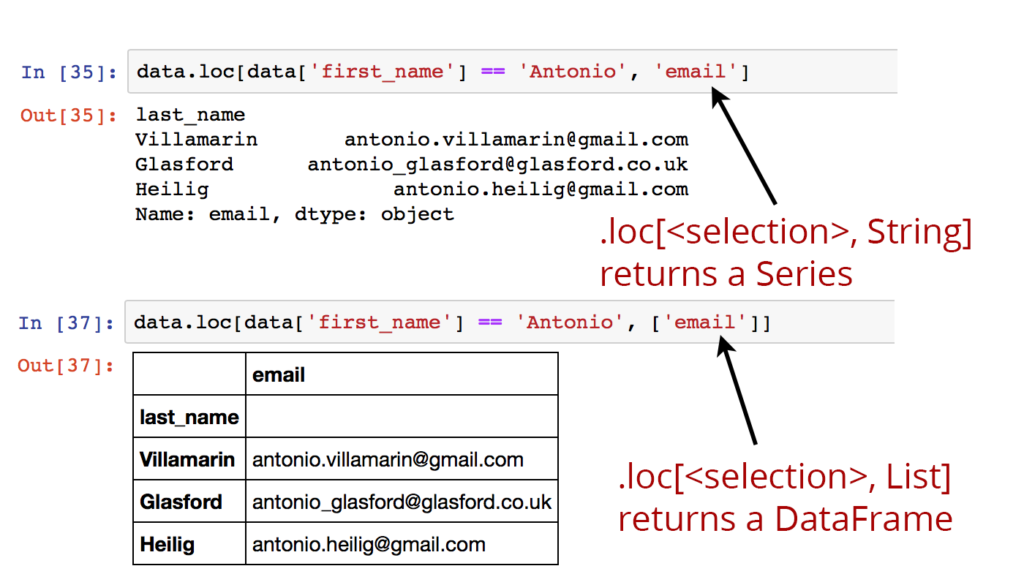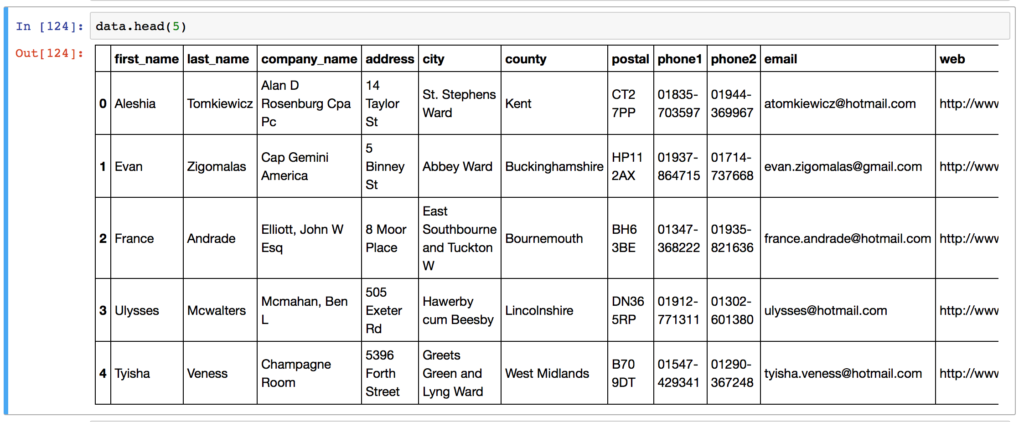Pandas Data Selection
There are multiple ways to select and index rows and columns from Pandas DataFrames. I find tutorials online focusing on advanced selections of row and column choices a little complex for my requirements, but mastering the Pandas iloc, loc, and ix selectors can actually be made quite simple.
Selection Options
There’s three main options to achieve the selection and indexing activities in Pandas, which can be confusing. The three selection cases and methods covered in this post are:
- Selecting data by row numbers (.iloc)
- Selecting data by label or by a conditional statement (.loc)
- Selecting in a hybrid approach (.ix) (now Deprecated in Pandas 0.20.1)
Data Setup
This blog post, inspired by other tutorials, describes selection activities with these operations. The tutorial is suited for the general data science situation where, typically I find myself:
- Each row in your data frame represents a data sample.
- Each column is a variable, and is usually named. I rarely select columns without their names.
- I need to quickly and often select relevant rows from the data frame for modelling and visualisation activities.
For the uninitiated, the Pandas library for Python provides high-performance, easy-to-use data structures and data analysis tools for handling tabular data in “series” and in “data frames”. It’s brilliant at making your data processing easier and I’ve written before about grouping and summarising data with Pandas.

Selection and Indexing Methods for Pandas DataFrames
For these explorations we’ll need some sample data – I downloaded the uk-500 sample data set from www.briandunning.com. This data contains artificial names, addresses, companies and phone numbers for fictitious UK characters. To follow along, you can download the .csv file here. Load the data as follows (the diagrams here come from a Jupyter notebook in the Anaconda Python install):
1. Pandas iloc data selection
The iloc indexer for Pandas Dataframe is used for integer-location based indexing / selection by position.
The iloc indexer syntax is data.iloc[<row selection>, <column selection>], which is sure to be a source of confusion for R users. “iloc” in pandas is used to select rows and columns by number, in the order that they appear in the data frame. You can imagine that each row has a row number from 0 to the total rows (data.shape[0]) and iloc[] allows selections based on these numbers. The same applies for columns (ranging from 0 to data.shape[1] )
There are two “arguments” to iloc – a row selector, and a column selector. For example:
Multiple columns and rows can be selected together using the .iloc indexer.
There’s two gotchas to remember when using iloc in this manner:
- Note that .iloc returns a Pandas Series when one row is selected, and a Pandas DataFrame when multiple rows are selected, or if any column in full is selected. To counter this, pass a single-valued list if you require DataFrame output.

In practice, I rarely use the iloc indexer, unless I want the first ( .iloc[0] ) or the last ( .iloc[-1] ) row of the data frame.
2. Pandas loc data selection
The Pandas loc indexer can be used with DataFrames for two different use cases:
- a.) Selecting rows by label/index
- b.) Selecting rows with a boolean / conditional lookup
The loc indexer is used with the same syntax as iloc: data.loc[<row selection>, <column selection>] .
2a. Label-based / Index-based indexing using .loc
Selections using the loc method are based on the index of the data frame (if any). Where the index is set on a DataFrame, using <code>df.set_index()</code>, the .loc method directly selects based on index values of any rows. For example, setting the index of our test data frame to the persons “last_name”:
Now with the index set, we can directly select rows for different “last_name” values using .loc[<label>] – either singly, or in multiples. For example:

Select columns with .loc using the names of the columns. In most of my data work, typically I have named columns, and use these named selections.

You can select ranges of index labels – the selection </code>data.loc[‘Bruch’:’Julio’]</code> will return all rows in the data frame between the index entries for “Bruch” and “Julio”. The following examples should now make sense:
Note that in the last example, data.loc[487] (the row with index value 487) is not equal to data.iloc[487] (the 487th row in the data). The index of the DataFrame can be out of numeric order, and/or a string or multi-value.
2b. Pandas Loc Boolean / Logical indexing
Conditional selections with boolean arrays using data.loc[<selection>] is the most common method that I use with Pandas DataFrames. With boolean indexing or logical selection, you pass an array or Series of True/False values to the .loc indexer to select the rows where your Series has True values.
In most use cases, you will make selections based on the values of different columns in your data set.
For example, the statement data[‘first_name’] == ‘Antonio’] produces a Pandas Series with a True/False value for every row in the ‘data’ DataFrame, where there are “True” values for the rows where the first_name is “Antonio”. These type of boolean arrays can be passed directly to the .loc indexer as so:

As before, a second argument can be passed to .loc to select particular columns out of the data frame. Again, columns are referred to by name for the loc indexer and can be a single string, a list of columns, or a slice “:” operation.

Note that when selecting columns, if one column only is selected, the .loc operator returns a Series. For a single column DataFrame, use a one-element list to keep the DataFrame format, for example:

Make sure you understand the following additional examples of .loc selections for clarity:
Logical selections and boolean Series can also be passed to the generic [] indexer of a pandas DataFrame and will give the same results: data.loc[data[‘id’] == 9] == data[data[‘id’] == 9] .
3. Selecting pandas data using ix
Note: The ix indexer has been deprecated in recent versions of Pandas, starting with version 0.20.1.
The ix[] indexer is a hybrid of .loc and .iloc. Generally, ix is label based and acts just as the .loc indexer. However, .ix also supports integer type selections (as in .iloc) where passed an integer. This only works where the index of the DataFrame is not integer based. ix will accept any of the inputs of .loc and .iloc.
Slightly more complex, I prefer to explicitly use .iloc and .loc to avoid unexpected results.
As an example:
Setting values in DataFrames using .loc
With a slight change of syntax, you can actually update your DataFrame in the same statement as you select and filter using .loc indexer. This particular pattern allows you to update values in columns depending on different conditions. The setting operation does not make a copy of the data frame, but edits the original data.
As an example:
That’s the basics of indexing and selecting with Pandas. If you’re looking for more, take a look at the .iat, and .at operations for some more performance-enhanced value accessors in the Pandas Documentation and take a look at selecting by callable functions for more iloc and loc fun.


![Pandas Dataframe with index set using .set_index() for .loc[] explanation.](https://c8j9w8r3.rocketcdn.me/wp-content/uploads/2016/09/index_set_dataframe-1024x497.png)
yes, indeed. Your posting is very helpful to help me understand the usage of loc and iloc. Thank You. Another question to ask: Is there any kind of website which we can discuss about Python topics, and post questions?
stackoverflow.com is the default page for questions regarding concrete issues. For discussions regarding specific package changes I recommend using the associate github page for the package. For general discussions about python I use quora.com
These are really helpful for beginners. Thanks a lot
Hi is there anyway for me to update a column in one dataset using a reference value from another dataset ?
similar to having 2 tables with a key shared between the 2 in a 1 to many relationship
Hi Michael, your best bet there is to look at pandas.merge – you can join two datasets together based on a common value, and then use the matched values as your replacement. There’s another post on this site that might help you out.
One of the best explanations for this material that I’ve seen anywhere on the internet. Thank you!
Completely agree!
Thank you so much for this!!
Thanks a ton! 🙂
Thank you for a very clear, and helpful exposition.
how can ı set if my variable string and integer same time? iloc? loc ? for example first column integer and 2. column string ı want use both independent ?
Hi Ali, it would be good to see a code example if you have one. But you should be able to achieve any set of selections using logical combinations (&& and ||) for example:
data.loc[(data['string_column'] == 'test1') & (data['numeric_column'] > 5), 'column_to_change'] = 'new_value'thank you so much this is the best explanation i have came across on the internet, helped a lot.
Very good useful and clear explanation on loc and iloc
What happened to ‘last_name’ after running:
data.set_index(‘id’, inplace=True)
Thanks!
[…] Reference — pandas 0.23.1 documentation Using iloc, loc, & ix to select rows and columns in Pandas DataFrames pandas の loc、iloc、ix の違い – […]
Hi, is it possible to find the maximum value and minimum value from a list of 55 column and 5000 rows? I want Final Value = 0.9/Maxmium-minimum for each column and the output in all 55 column.
Check these screenshots.
[…] https://www.shanelynn.ie/select-pandas-dataframe-rows-and-columns-using-iloc-loc-and-ix/ […]
Thats great, thax alot.
This is an great article. Very clear information with examples
Thanks for the write-up. Very helpful.
Thank you very much, keep posting.
Much appreciated, this was very helpful!
Nice writeup!
[…] To select individual elements based on their row and column number, we can use the iloc function with iloc[row number, column number] specified. It is crucial to note that the index for […]
[…] Selecting Rows and Columns in Pandas Dataframes […]
You wrote:
“Note that .iloc returns a Pandas Series when one row is selected, and a Pandas DataFrame when multiple rows are selected, **or if any column in full is selected**.”
when tested:
>>> type(data.iloc[:,-1])
last column is fully selected, why it is still a series?
Hi John, You’re correct. The text should actually read – “note that .iloc returns a Series when only one row OR COLUMN is selected…”. Basically -if you pass in a list to the selector, you’ll end up with a DataFrame instead: Try: data.iloc[:, [-1]]
typeo: data.loc[idx, [’email’, ‘first_name’, ‘company’]] should be data.loc[idx, [’email’, ‘first_name’, ‘company_name’]]
[…] Using iloc, loc, & ix to select rows and columns in Pandas DataFrames […]
[…] Using iloc, loc, & ix to select rows and columns in Pandas DataFrames […]
This is an excellent write up with very useful examples.Thanks for sharing the knowledge.
Great examples.
thanks for the useful information.
Beautifully explained.